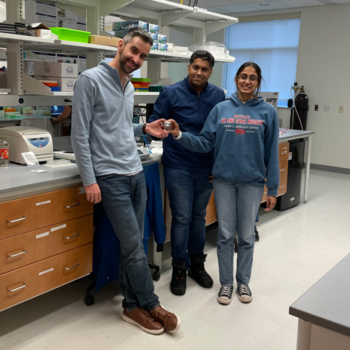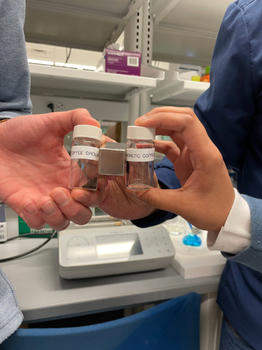The most elegant solutions are sometimes the simplest, like using one waste product to eliminate another. By combining spent coffee grounds with iron oxide (aka rust), Mason engineers have created CoffeeBots, which can bind to several different pollutants in seawater before being removed via magnets.

Photo by Teresa Donnellan.
High school lab assistant Tarini Basireddy, post-doc Amit Kumar Singh, and assistant professor Jeff Moran recently published their findings in Nanoscale demonstrating how their invention, which they call “CoffeeBots,” can effectively remove three types of pollutants from seawater: oil, microplastics, and methylene blue.
Singh proposed creating CoffeeBots as a way for Basireddy to gain hands-on experience without having to interact with the many dangerous chemicals in Moran’s laboratory, which focuses mainly on developing artificial, self-propelled microparticles for different medical and environmental applications.
“Tarini and Amit developed a simple strategy to coat spent coffee grounds, which I brought from home after brewing my morning coffee, with iron oxide nanoparticles,” said Moran.
Coffee grounds have a porous, irregular surface, so they have ample surface area to which pollutants can bind, even with much smaller iron oxide nanoparticles attached, he explained. Moreover, because iron oxide is magnetic, a simple handheld magnet can both drive CoffeeBots through polluted water and remove them once they have absorbed the pollutants. Basireddy used Fourier transform infrared (FTIR) spectroscopy to confirm that the iron oxide nanoparticles had bonded to the coffee grounds.
“Tarini’s extensive research experience and skillset were crucial to the success of this project," Moran noted. She’s way ahead of where I was at her age.”
While using coffee grounds to clean up oil spills is not entirely new, this team is the first to show that moving CoffeeBots outperform stationary ones at removing pollutants, since moving CoffeeBots encounter pollutant molecules more often than stationary coffee grounds do. Making the coffee grounds magnetic has another benefit: Once the CoffeeBots are recovered, they can be reused several times with little loss in water-cleaning efficacy.
Methylene blue

CoffeeBots are drawn to magnets.
Photo by Teresa Donnellan.
The team assessed how CoffeeBots fare in seawater polluted with methylene blue, a dye commonly used in textile production. In addition to being a carcinogen, Basireddy explained, methylene blue can cause serious health problems: “It can cause skin irritation, if there's too much in the water; it can cause a lot of digestive problems; it can cause nausea, fever, lots of symptoms.” She added that it can negatively impact marine life as well.
The team found CoffeeBots can be an effective solution for cleaning methylene blue from seawater, especially when they are first also loaded with ascorbic acid, which helps break down the dye and render it nontoxic. Basireddy noted the potential simplicity of a CoffeeBots-based solution to methylene blue pollution, saying, “It's cool because the countries that are big textile producers also happen to be the countries that are big in coffee production.” The team cited Brazil, Colombia, Ethiopia, India, Peru, and Vietnam as countries that produce both dyed textiles and coffee and struggle with water pollution.
Oil and microplastics
The final pollutant tested is perhaps the most exciting, as it’s been a burgeoning topic of concern in recent years: microplastics. In water, microplastics cling to coffee grounds for the same reason that oil does: each substance is hydrophobic.
“One reason why microplastics and nanoplastics are such a tricky environmental problem is that they're so small, and that makes it difficult to locate them just to remove them,” said Moran. “By driving the CoffeeBots through the water, the hydrophobic interactions cause the microplastic particles to build up and accumulate on the surface of the coffee grounds.”
Singh noted that, while other (perhaps more expensive) techniques exist for remediating oil spills and removing chemical pollutants from water, developing a technique to make microplastic removal more efficient is an exciting new development.
Further plans
The team has applied for a patent to protect the technology and are excited to determine the full capabilities of CoffeeBots. They are optimistic because CoffeeBots are potentially a simple, inexpensive solution to water pollution.
While Basireddy has moved on to her freshman year at Johns Hopkins University, Singh and Moran look forward to finding further applications for CoffeeBots and possibly improving their technology. For example, Singh hopes to find a way to make CoffeeBots move when activated by sunlight, which would enable them to propel themselves through the water without the need for an external magnet. In addition, the team plans to explore the full range of pollutants that can be removed by CoffeeBots and characterize the efficacy of different coffee types.
Get a more detailed look at the team's experiments by reading their paper in Nanoscale, “Eliminating waste with waste: transforming spent coffee grounds into microrobots for water treatment,” which includes several videos of CoffeeBots in action, such as the one below. In addition, Singh created a video to promote CoffeeBots on YouTube.
In This Story
Related News
- November 24, 2025
- November 11, 2025
- October 28, 2025
- October 27, 2025
- October 21, 2025
This content appears in the Summer 2024 print edition of the Mason Spirit Magazine with the title "Coffee Bots to the Rescue."
